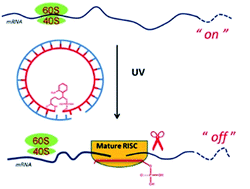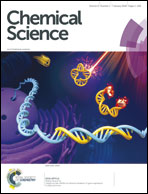Caged circular siRNAs for photomodulation of gene expression in cells and mice†
Abstract
By means of RNA interference (RNAi), small interfering RNAs (siRNAs) play important roles in gene function study and drug development. Recently, photolabile siRNAs were developed to elucidate the process of gene silencing in terms of space, time and degree through chemical modification of siRNAs. We report herein a novel type of photolabile siRNA that was synthesized through cyclizing two ends of a single stranded RNA with a photocleavable linker. These circular siRNAs became more resistant to serum degradation. Using reporter assays of firefly/Renilla luciferase and GFP/RFP, the gene silencing activities of caged circular siRNAs for both genes were evaluated in HEK293 cells. The results indicated that the target genes were successfully photomodulated using these caged circular siRNAs that were formed by caged circular antisense guide RNAs and their linear complementary sense RNAs. Using the caged circular siRNA targeting GFP, we also successfully achieved photomodulation of GFP expression in mice. Upon further optimization, this new type of caged circular siRNA is expected to be a promising tool for studying gene therapy.



 Please wait while we load your content...
Please wait while we load your content...